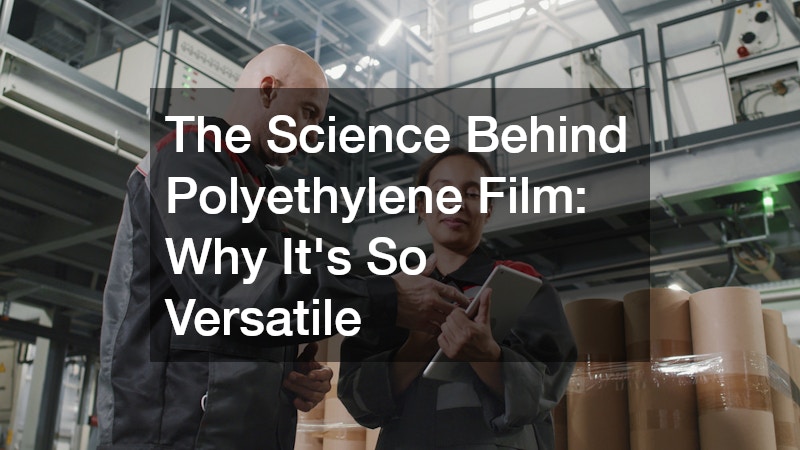

Polyethylene film is one of the most widely used materials in the world, yet many people rarely think about the science that makes it so versatile. From packaging products in grocery stores to protecting crops in agriculture, polyethylene film has become an indispensable material across countless industries. Its unique combination of strength, flexibility, and chemical resistance makes it a preferred choice for applications that demand reliability and efficiency. In this blog, we’ll explore the science behind polyethylene film, how it is made, and why it continues to be a material of choice for businesses and consumers alike.
What Is Polyethylene Film?
Polyethylene film is a type of plastic made from polymerized ethylene, a hydrocarbon derived from petroleum or natural gas. Essentially, polyethylene is a long chain of repeating ethylene molecules, which gives the material its remarkable durability and flexibility. The term “film” refers to polyethylene in a thin, sheet-like form, which can range from microns to millimeters in thickness depending on the intended application.
There are several types of polyethylene film, each with distinct properties:
-
Low-Density Polyethylene (LDPE): Known for its flexibility, transparency, and moisture resistance, LDPE is commonly used in grocery bags, shrink wraps, and protective coverings.
-
High-Density Polyethylene (HDPE): Stronger and more rigid than LDPE, HDPE is often used in heavier-duty applications, such as construction sheeting, industrial packaging, and agricultural films.
-
Linear Low-Density Polyethylene (LLDPE): Combines flexibility and strength, making it ideal for stretch films, pallet wraps, and multilayer packaging.
Each type of polyethylene film is engineered for specific requirements, offering a balance of strength, durability, and ease of processing.
The Science of Polyethylene Film: Molecular Structure and Properties
The versatility of polyethylene film comes down to its molecular structure. Polyethylene is a polymer, meaning it is made up of long chains of repeating monomers (ethylene molecules). The arrangement of these chains determines the film’s physical properties.
-
Crystallinity: HDPE has a more crystalline structure, which makes it stronger, more rigid, and more resistant to chemical attack. LDPE, on the other hand, has a more branched and amorphous structure, which allows for greater flexibility and clarity.
-
Density: The density of the polymer affects tensile strength and stretchability. Lower-density films are softer and stretchier, while higher-density films provide rigidity and puncture resistance.
-
Barrier Properties: Polyethylene films offer excellent moisture and chemical resistance. This makes them ideal for packaging food products, medical supplies, and chemicals, protecting contents from contamination and environmental factors.
These molecular characteristics are precisely manipulated during manufacturing, allowing producers to create films suited for very specific applications.
How Polyethylene Film Is Made
Polyethylene film is typically produced using one of two primary processes: blown film extrusion or cast film extrusion.
-
Blown Film Extrusion: In this method, molten polyethylene is forced through a circular die to form a thin tube. Air is then blown into the tube, expanding it into a bubble. The bubble is cooled and flattened into rolls of film. This technique is widely used for LDPE and LLDPE films and is ideal for creating films with uniform thickness and excellent mechanical properties.
-
Cast Film Extrusion: Here, molten polyethylene is extruded through a flat die onto chilled rollers to cool and solidify the film. Cast film is smoother and clearer than blown film and is commonly used for applications requiring high optical clarity and precise thickness control.
Both methods allow manufacturers to adjust properties such as thickness, elasticity, and transparency, tailoring the film to specific industrial or consumer needs.

Applications Across Industries
The unique combination of properties offered by polyethylene film allows it to be used in a variety of industries:
-
Packaging: Polyethylene film is essential for protecting goods during shipping and storage. Stretch films, shrink wraps, and bags help secure products, reduce damage, and extend shelf life.
-
Agriculture: Farmers use polyethylene films for greenhouse covers, mulch films, and silage wraps. The films protect crops from pests, control moisture levels, and enhance plant growth.
-
Construction: HDPE films are used as vapor barriers, protective sheeting, and insulation backing. They prevent moisture intrusion and improve energy efficiency in buildings.
-
Medical and Hygiene: Polyethylene films are used in sterile packaging, medical drapes, and disposable garments. Their chemical resistance and barrier properties ensure safety and hygiene.
This broad range of applications highlights the material’s adaptability and the importance of its molecular design in meeting varied functional requirements.
Environmental Considerations
While polyethylene film offers numerous advantages, environmental concerns have driven innovation in sustainable solutions. Advances include the development of recyclable films, biodegradable options, and multi-layer films that reduce overall material usage without sacrificing performance. Many industries are also implementing recycling programs to collect and process used polyethylene films, helping reduce environmental impact while maintaining functionality.
Polyethylene film is more than just a flexible sheet of plastic—it is a marvel of modern materials science. Its versatility comes from carefully engineered molecular structures, which give it the perfect balance of strength, flexibility, and resistance to moisture and chemicals. By understanding the science behind polyethylene film, businesses and consumers can better appreciate why it continues to play a crucial role in packaging, agriculture, construction, and healthcare. Whether you are securing products, protecting crops, or ensuring safety in medical settings, polyethylene film provides a reliable, adaptable solution. Its continued innovation in both performance and sustainability ensures that this remarkable material will remain a cornerstone of modern industry for years to come.






